“Words like ‘slaughter,’ ‘massacre’ and ‘carnage’ often convey more emotion than information,” wrote New York Times standards desk editor Susan Wessling in a November 2023 memo to the staff of the “paper of record.” It was over a month into the current U.S.-Israeli war on Gaza. Over 10,000 Palestinians had been martyred by the occupation forces. Congress had voted to send tens of billions more in lethal military aid to the Zionist entity. Wessling added, “Think hard before using [words like 'slaughter'] in our own voice.”
Why were Times employees told to “think hard” about conveying “more emotion than information?” Wessler did not specify. But nothing in this memo was new; it was a series of implicit reminders. Think hard about which narrative you’re constructing. Who your bosses are. Who your president is. Who your bosses and your president say the enemy is.
As anyone who had spent time during the last 18 months in the newsroom well knew, The New York Times has no qualms about emotionally condemning war crimes committed by enemies of the U.S. empire.
“CARNAGE WIDENS AS CEASEFIRE TALKS FALTER” was the front-page headline on March 11, 2022, accompanied by six aerial photos showing Russia’s invasion of Ukraine. On April 5 after Russian forces withdrew from the Kyiv suburb of Bucha, leaving behind dozens of corpses, the front page read, “HORROR GROWS OVER SLAUGHTER IN UKRAINE.”
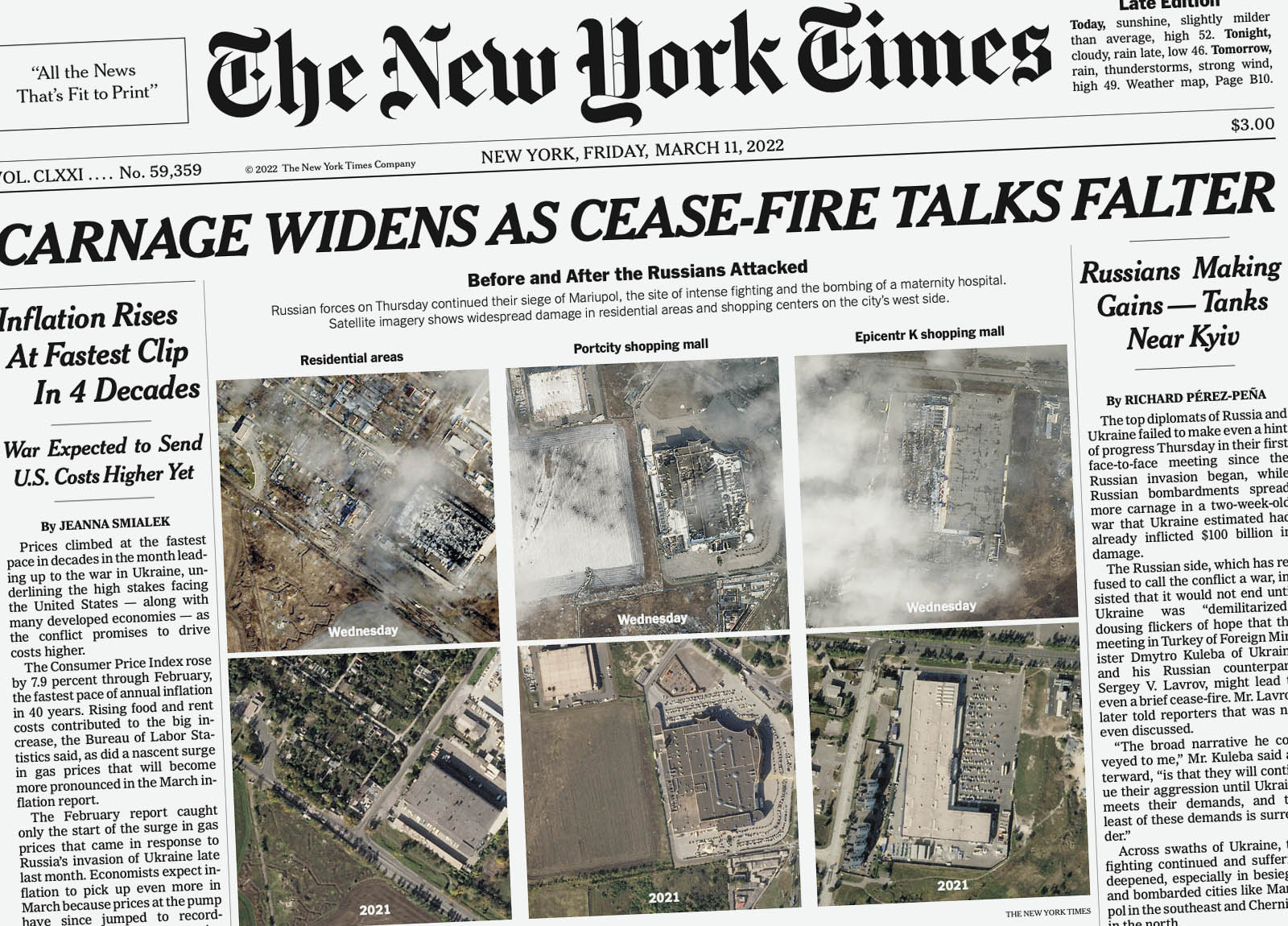
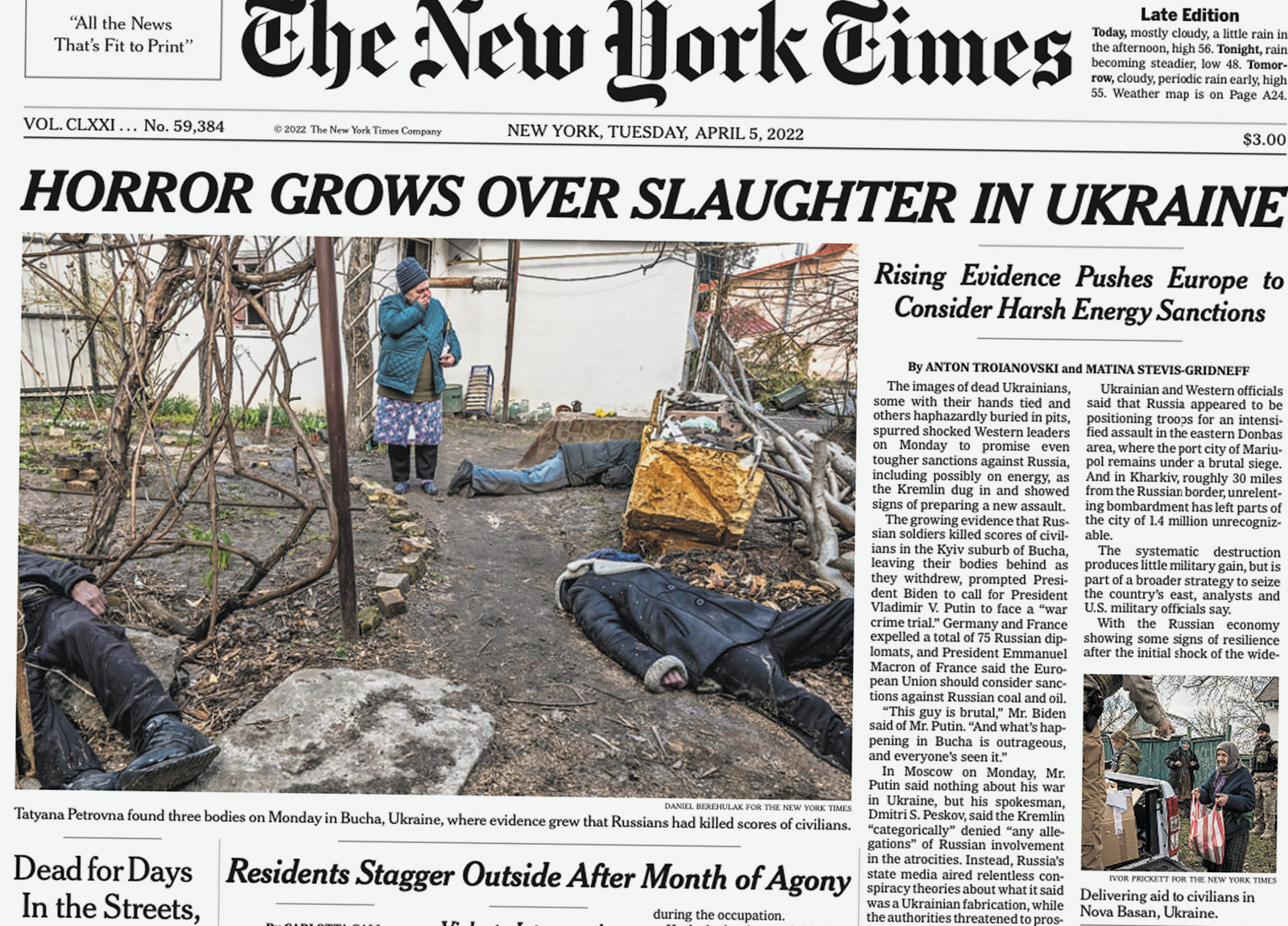
Ukraine and Gaza are not perfect historical parallels. But the Russian invasion of Ukraine still provides a useful point of comparison to Israel’s genocidal war on Gaza. Both have occupied the media’s attention for months on end, and both represent struggles deeply embroiled in U.S. empire. (The argument that there is a breach in parallels because Gaza “started it” on October 7 only holds up if one ignores the forced expulsion, apartheid, and occupation imposed on Palestinians by Zionists for the last century.)
Russia is a demonstrable threat to U.S. foreign policy interests, and as such, The Times presents its actions in the harshest terms possible while uplifting Ukranians resisting Russian invasion as front-line defenders of the Western way of life. (And of course, The US and NATO bear responsibility for proposing a pathway to NATO membership for Ukraine, a move they knew would provoke Russia – while simultaneously delaying that membership to shirk direct responsibility for Ukraine’s defense if and when Russia invaded. Ukrainians were placed in the middle of this bloody geopolitical dispute.)
In contrast, Israel is the United States’ closest ally in the Middle East and has acted as a proxy for its regional interests for decades. The United States has a vested interest in sustaining and defending the Zionist project – a project which necessitates the physical and cultural erasure of Palestinians. And mainstream Western media outlets like The Times dutifully use their pages to launder this interest.
Through a survey of every article The Times wrote during the first six months of the Russian invasion of Ukraine (and quite a few beyond that point), Writers Against the War on Gaza/The New York War Crimes conducted a comparative, qualitative study of The New York Times coverage of the Russian invasion of Ukraine with its coverage of Israel’s genocidal war on Gaza.
We’ve separated this study into four sections: War Crimes; Resistance; Ukraine Needs Weapons!; and Culture. Each section demonstrates a contrast between coverage of Russia’s invasion of Ukraine and Israel’s genocidal war on Gaza.
The Times reporting consistently condemns war crimes committed by Russia while in Gaza, it either obfuscates their nature or legitimizes Israel’s excuses for committing them. In Gaza the accusation that resistance fighters operate amongst civilians grants carte blanche for Israeli war crimes; in Ukraine the tactic is framed as that of a wily and brave resistance struggling against a military with vastly superior firepower. Ukraine’s “outgunned” army always needs more weapons, while the notion of The Times suggesting so for Hamas is absurd. And while the paper has provided in-depth coverage of the art and culture that is at risk of being lost in Ukraine, it has categorically ignored Israel’s violent campaign to erase Palestinian cultural production.
War Crimes
By the time Wessling’s memo was distributed to her staff, The Times had already splashed words like “slaughter,” “horror,” “massacre” and “trail of terror” across their pages when covering the Hamas-led attack on Israel on Oct. 7. An Intercept analysis found that between Oct. 7 and Nov. 24, “The New York Times had described Israeli deaths as a ‘massacre’ on 53 occasions and those of Palestinians just once. The ratio for the use of ‘slaughter’ was 22 to 1, even as the documented number of Palestinians killed climbed to around 15,000.”
While The Times has equivocated, justified, ignored and soberly depicted Israeli war crimes, our analysis reveals a preference towards condemning Russian crimes with deeply affective language.
This front page story both unequivocally categorizes Russians as “invaders” and vividly condemns “horror,” “death and terror,” “atrocities,” “mass killings, torture and rapes.”
There is no qualification or both-sidesing of the story, and no deflection of blame, as we have come to expect from The Times coverage of Gaza, in which the IDF is both the invading army and the main journalistic source. The stories about Ukraine – an occupying army destroying and looting houses, while shooting, torturing and committing sexual abuse – depict precisely what the IDF has done in Palestine for decades, and at an accelerated pace over the last 10 months. But stories this direct and condemnatory about Israel’s war crimes do not appear in the pages of The New York Times.
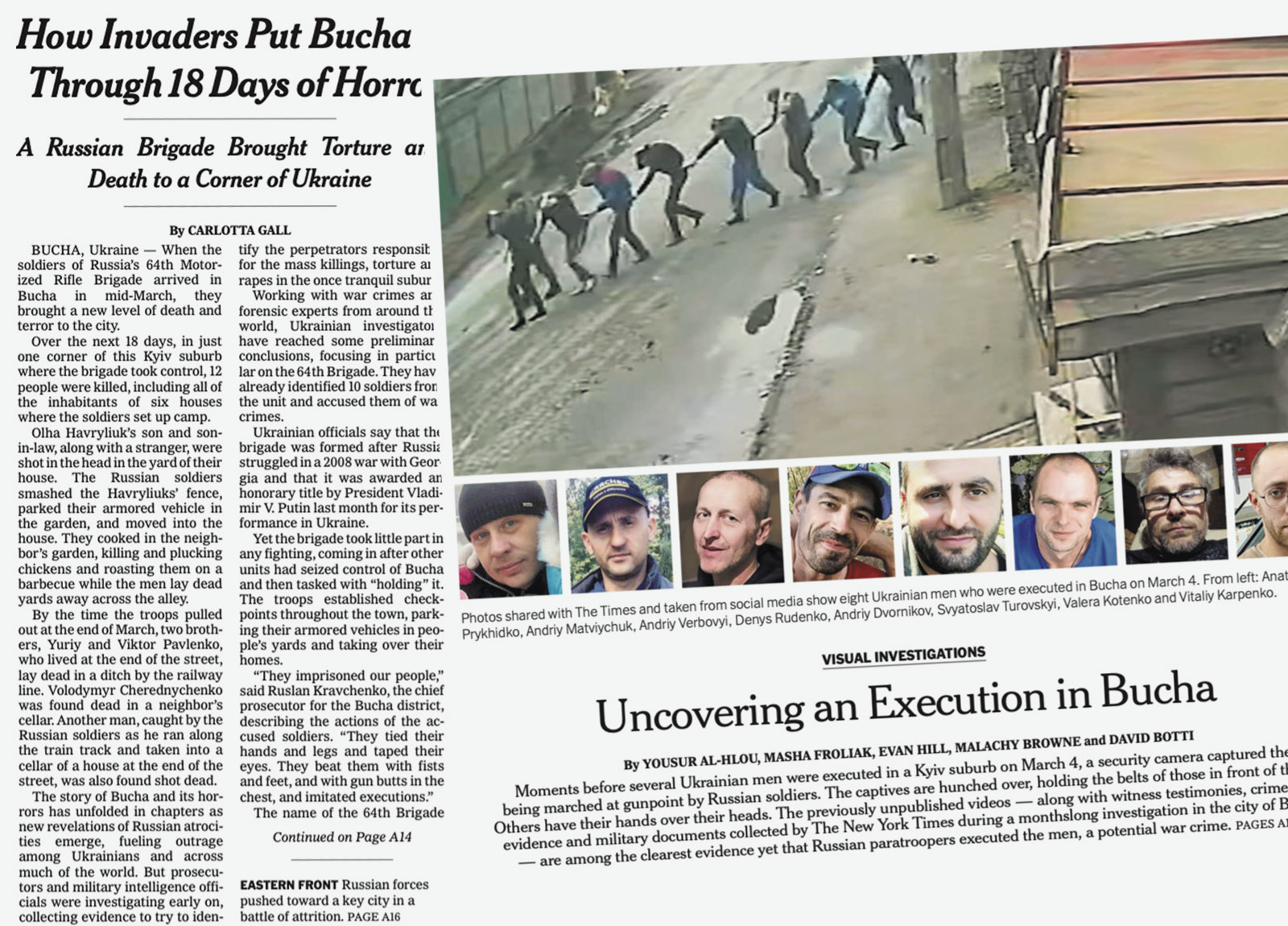
Devastating images splayed across its front pages, accompanied by deeply emotional appeals to the humanity of Ukrainians and the inhumanity of Russian forces, are ubiquitous throughout The Times’ coverage of the war in Ukraine. In other news articles, the paper writes authoritatively of “the indiscriminate slaughter that characterizes Moscow’s prosecution of the war.”
You can find more examples of The Times reporting on Russian atrocities here.
The Times went so far as to set up an interactive page (Documenting Atrocities in the War in Ukraine) devoted to documenting Russian war crimes (there is one story on a Ukrainian unit executing Russian prisoners). No such page exists for Israel’s war crimes, which include well-documented attacks on schools, hospitals, aid workers, journalists, markets, water facilities, apartment blocks, mosques and refugee camps.
The Times does not hesitate to describe Russia’s “bombing of civilian targets” in clear and direct terms, nor do they attempt to justify or “both sides” Russia’s tactics, as is their first impulse with the IDF.
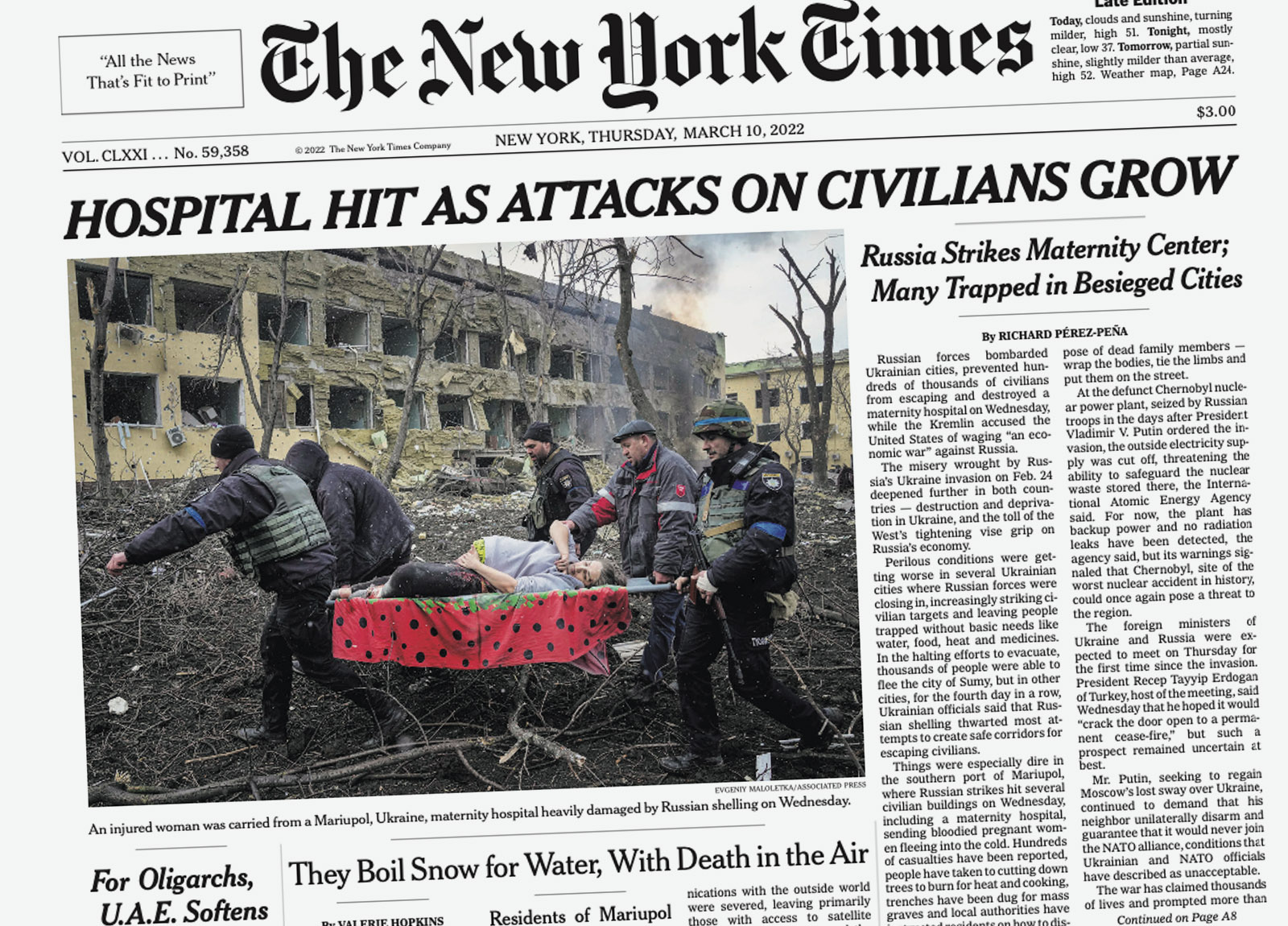

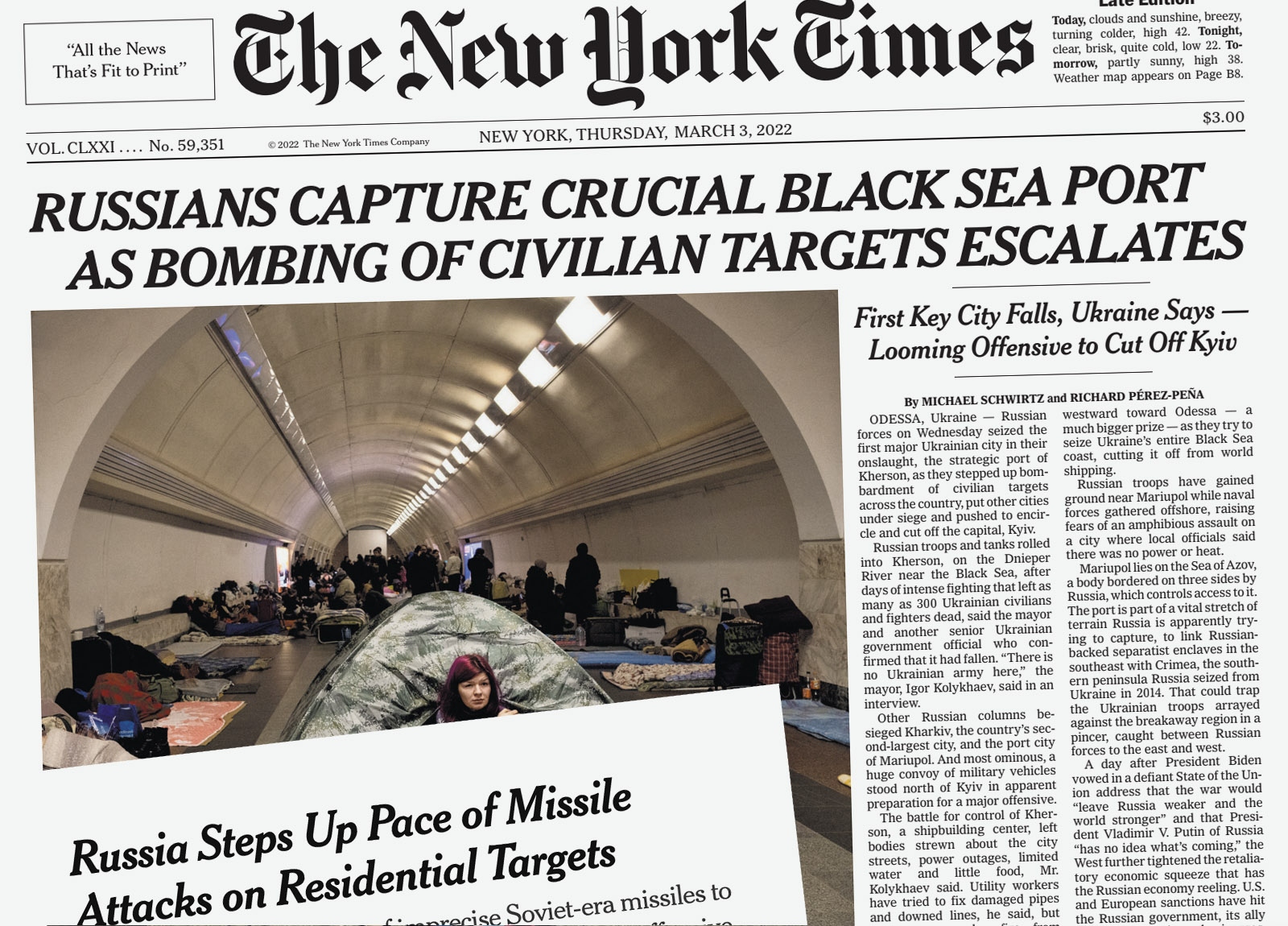
When the IDF began its first deadly siege of al-Shifa Hospital in November, The Times continually portrayed the attack as an unfortunate consequence of the war, as civilians caught in the crossfire rather than as a deliberate attempt by Israel to incapacitate the health system in Gaza – even though the IDF has attacked every hospital in Gaza. They similarly gave credence to unproven U.S.-Israeli claims that Hamas was operating a “command and control center” out of al-Shifa. Some standard headlines during the brutal two week siege:
• “Gaza City Hospitals Are Caught in Deadly Crossfire”
• “Israel Says Military Has Entered Gazan Hospital Grounds to Root Out Hamas”
• “Gaza Hospitals Near Collapse as Fighting Rages Nearby”
• “Israeli Forces Near a Struggling Hospital They Say Covers a Hamas Complex”
On The Times’ Nov. 12 front page [left], Hamas’ Oct. 7 attack is described as a “slaughterhouse” while directly below, the IDF’s attack on Al-Shifa is portrayed in dry, equivocating language which legitimizes Israel’s excuses for assaulting the largest hospital in Gaza. On its Nov. 17 front page, The Times printed humanizing portraits of victims of the Oct. 7 attack alongside a story on the rise of their version of anti-semitism (which is quickly revealed to be a standard Times conflation with anti-Zionism), while the IDF’s ongoing attack on al-Shifa is described in legitimizing language: “Israelis Comb Gaza Hospital for an Enemy.” This usage of space forces a perspective that minimizes Israeli war crimes and maximizes depictions of Israeli suffering – disappearing Palestinians from view.

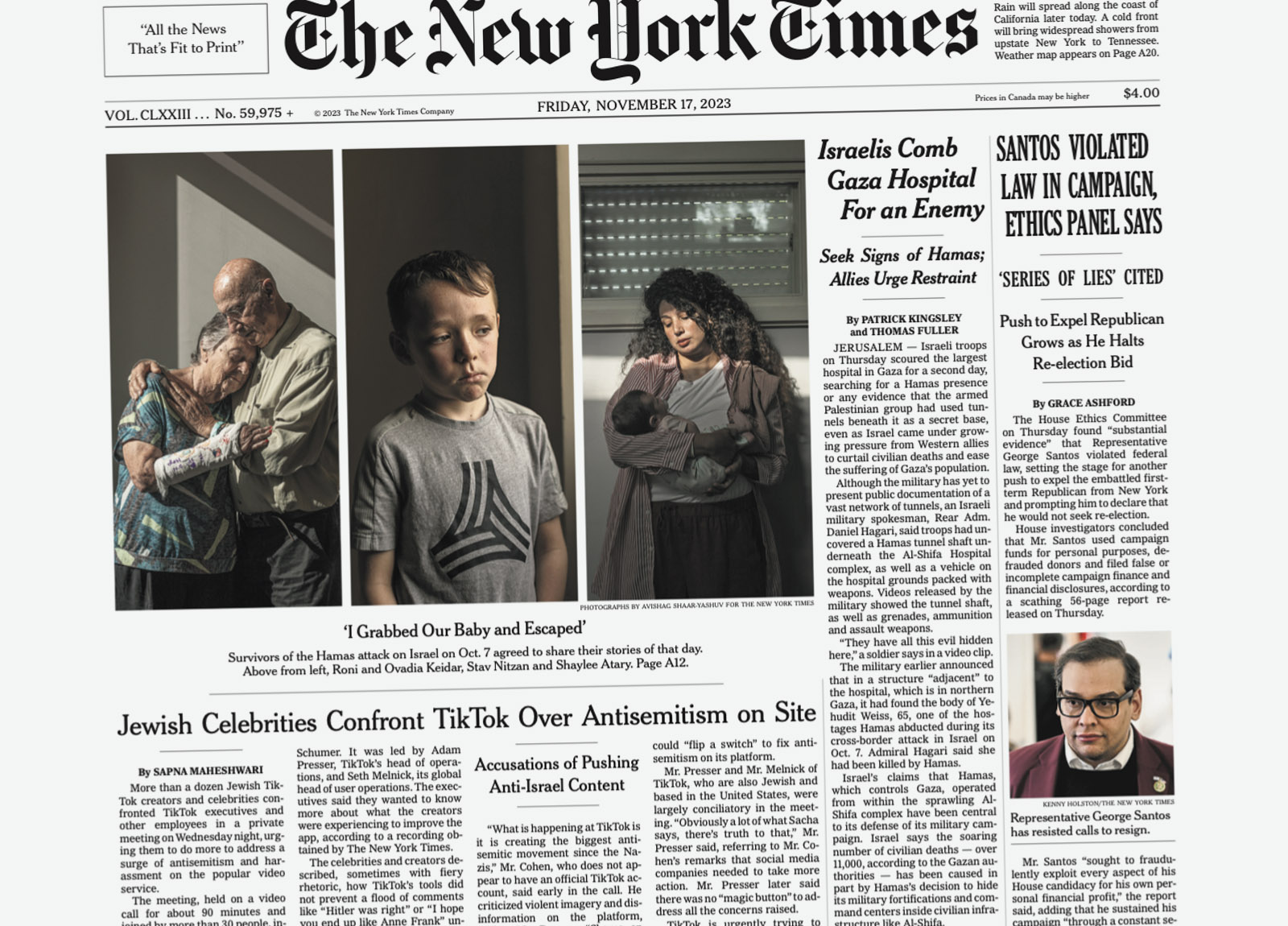
Predictably, editor David Leonhardt and The Times’ Morning newsletter, which reaches more than 17 million subscribers, presented a “both sides” narrative. His Nov. 14 newsletter, “The Debate Over Al-Shifa,” began,
“The battle over Al-Shifa Hospital in Gaza highlights a tension that often goes unmentioned in the debate over the war between Israel and Hamas: There may be no way for Israel both to minimize civilian casualties and to eliminate Hamas.”
Meanwhile, in a March 2022 Morning newsletter, “Russia’s Civilian Attacks,” Leonhardt is uncompromising in his condemnation of “Russia’s brutality toward Ukrainian civilians:”
“A Russian strike hit a hospital in Mariupol, a southern Ukrainian city near the Russian border. The complex included a children’s clinic and a maternity ward. Video showed blown-out windows in the hospital and a crater, more than 10 feet deep, in a courtyard . . . It was another apparent instance of Russia’s efforts to destroy civilian infrastructure in Mariupol.”
In one particularly infuriating article, Russia Repeatedly Strikes Ukraine’s Civilians. There’s Always an Excuse,” The Times writes with skepticism towards Russia’s excuses for targeting civilians – a skepticism that is not extended to Israel's repeated justifications for attacks on civilian targets and humanitarian safe zones in Gaza. The opening paragraphs are as revealing as they are maddening:
“Since late February, when Russia began pummeling Ukraine with missiles and artillery on a scale unseen in Europe for decades, civilian deaths have been as inevitable as the Russian excuses that follow.
“Attacks have struck people in bread lines and on playgrounds, as well as apartment blocks, theaters and hospitals. After each one, Russia has denied or deflected responsibility, often accusing Ukraine of attacking its own people to sway domestic and global opinion against Moscow.
“Russia has claimed that it aims only at targets of military value – even though some were hundreds of miles from the front lines – and that whenever a civilian facility did get hit, it was one that the Ukrainian military had co-opted for use as a command post, a shelter for foreign fighters or storage for weapons.”
Replace “Russia” with “Israel” and “Ukraine” with “Gaza” and you would get a very clear picture of how Israel’s public-relations apparatus attempts to justify its genocide.
The Times, of course, is notorious for platforming and legitimizing the IDF’s excuses for mass civilian casualties, despite its long and well-documented history of lying to the press. Most articles which describe deadly Israeli attacks on civilian infrastructure like hospitals, schools and apartment blocks include a qualification that Israel was targeting Hamas fighters who hide underneath or within civilian infrastructure, thus placing blame on Hamas. For example, when on July 13 the IDF dropped multiple 2,000 pound bombs on a refugee tent camp in el-Mawasi, a designated safe zone near Khan Younis, killing almost a hundred Palestinians, the front page Times article read: “Israel Launches Major Attack Against a Senior Hamas Commander.” The reader eventually learns of the high Palestinian death toll, but The Times again works to impress upon the reader the hard choices faced by the IDF when fighting Hamas. The next day, the publication followed that report with further legitimation of the intelligence which led to the murderous strike [left].
In this front page article [right] from Nov. 1 – the day after Israel dropped 2,000-pound bombs on Jabaliya refugee camp in Northern Gaza, murdering dozens of Palestinians and wounding hundreds more – The Times acknowledges the damage while still providing Israel with an excuse in its headline.
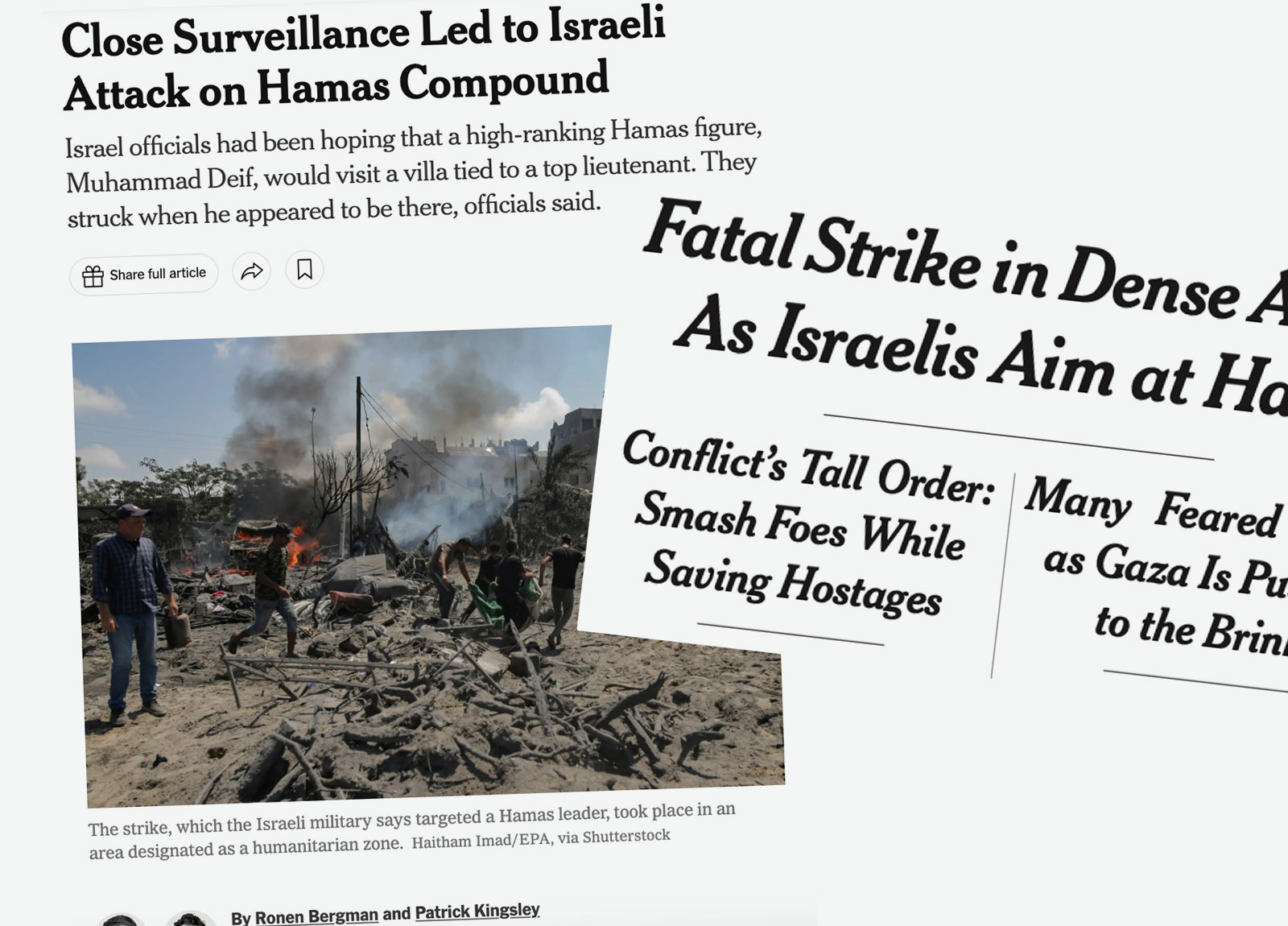
The Morning newsletter pushes this narrative at every opportunity. In one December 2023 newsletter, editor David Leonhardt wrote:
“Hamas has long hidden its fighters and weapons in and under populated civilian areas, such as hospitals and mosques. It does so partly to force Israel to make a gruesome calculation: To fight Hamas, Israel often must also harm civilians.”
The Times even used this justification to get ahead of the coming storm of international condemnation while the IDF was preparing to invade Gaza in October, writing in “The ‘Devil’s Playground’ of Urban Combat That Israel Is Preparing to Enter:”
“Israel has emphasized that it does not target civilians. But in urban battles, commanders often take fire from structures housing both fighters and families, forcing a judgment call: clear the rooms with troops, putting them at risk, or call in a heavier response that might kill civilians.”
In other instances, such as when Israel demonstrably targeted and assassinated seven aid workers with the World Central Kitchen, The Times presents the IDF as a well-meaning military which only targeted the aid workers due to a “cascade of errors.” The language of “mistakes” and “errors” is weaponized to imply that Israel is fundamentally well-intentioned and to obscure their long and well-documented history of targeting aid workers, medical professionals, journalists and other civilians (The Times has simply refused to substantively report on Israel’s mass murder of 165 journalists).
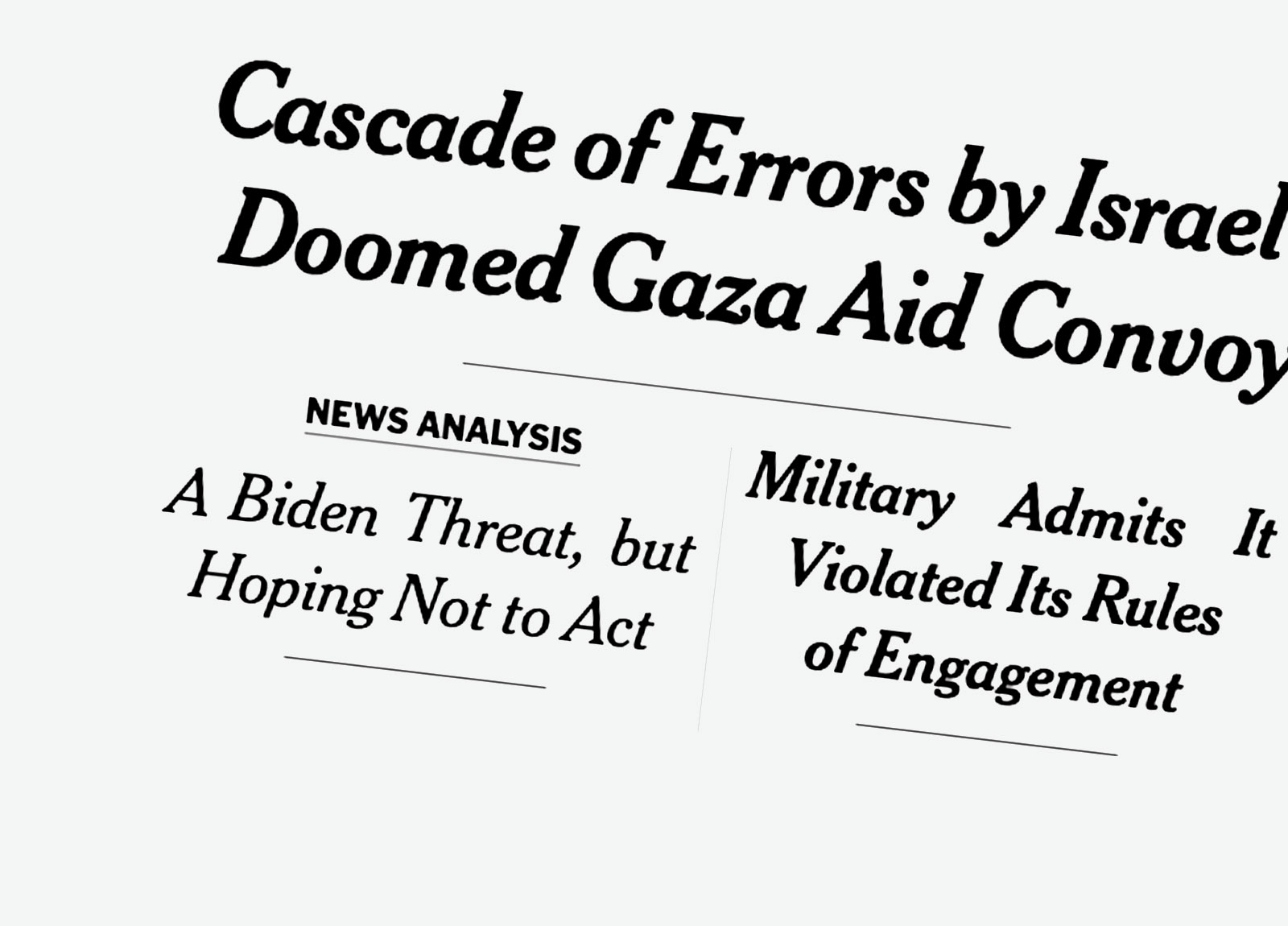
About a month into Russia’s invasion, The Times exhaustively mapped out each and every Russian attack on civilian infrastructure and residential areas in Ukraine, arguing that “Russia’s Attacks on Civilian Targets Have Obliterated Everyday Life in Ukraine.”
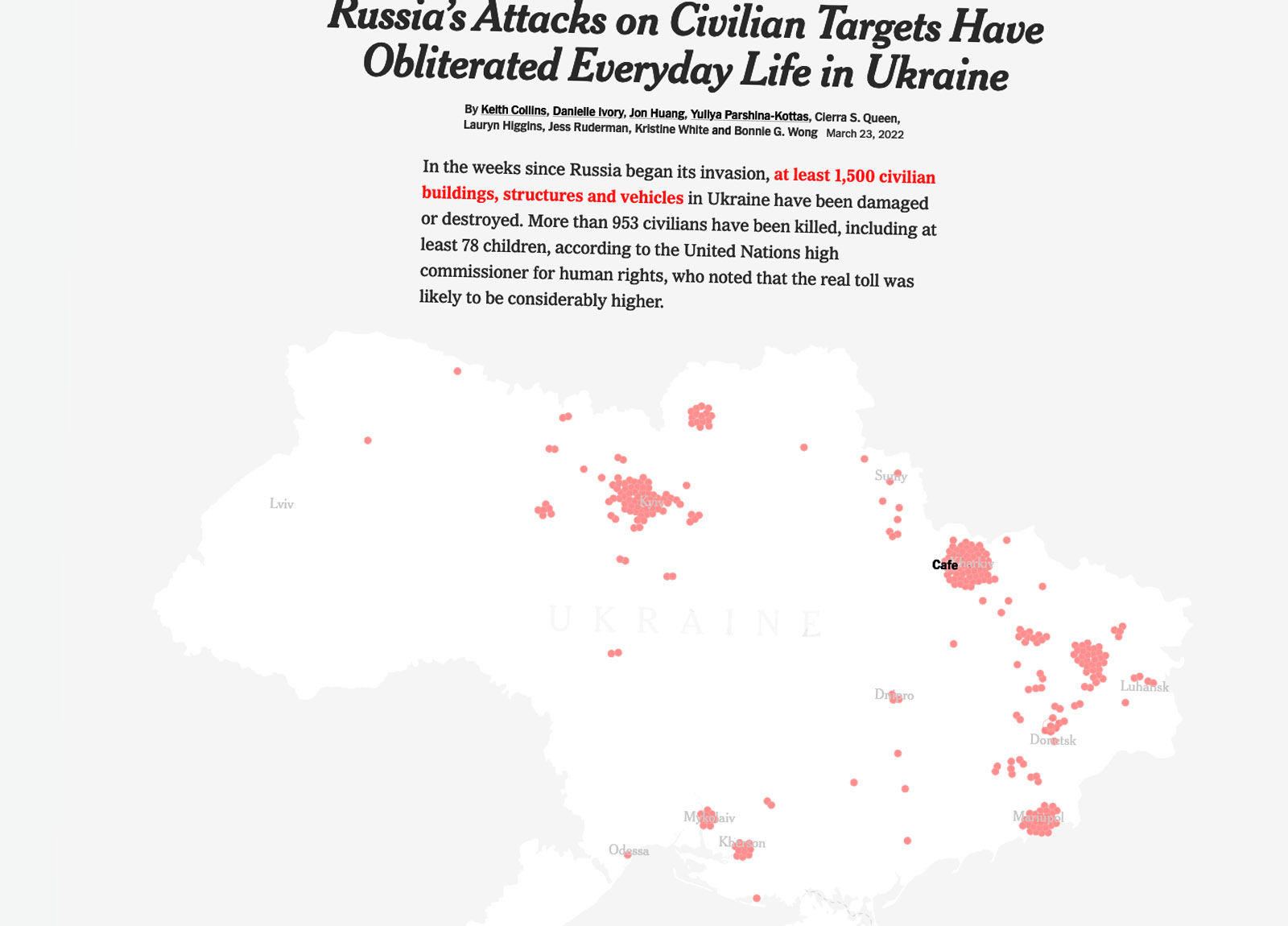
You can find more examples of The Times clear-eyed reporting on Russia targeting civilians and civilian infrastructure here.
When Russians are accused of war crimes by Western NGOs and the international courts, The Times is authoritative, lending wide credibility to the expertise and legal authority of those who condemn Putin and Russia for their conduct in the war (“‘Welcome to Hell’: U.N. Panel Says Russian War Crimes Are Widespread;” “The U.N. Details a “Horror Story of Abuses” in Ukraine;” “Arrest Warrant From ICC Pierces Putin’s Aura of Impunity;” “‘Abyss of Fear’: Report Accuses Russia of Further Abuses Against Civilians”) and publishing glowing profiles of human rights officials who are determined “to right historical wrongs and make sure Russians are held to account.”
Genocide is another word which The Times’ international editors warned their staff against using in their coverage of Israel’s war on Gaza. But in Ukraine, The Times had no problem platforming accusations of genocide and reporting with condemnatory language. In this May 2022 front-page article “Ferocious Russian Attacks Fuel Accusations of Genocide,” The Times does not self-censor – the word “carnage,” discouraged by Times editors in the Palestinian context, appears again:
“The increasing carnage and destruction inflicted by Russian forces in eastern Ukraine . . . led to fresh accusations Friday that President Vladimir V. Putin of Russia was waging a genocidal campaign to wipe out a substantial part of the Ukrainian population.
A new report by international legal scholars and human rights experts said mass killings, deliberate attacks on shelters and evacuation routes, and the indiscriminate bombardment of residential areas by Russian forces had established a ‘genocidal pattern’ against Ukrainians, in violation of the United Nations Genocide Convention.”
Again, this article would read as responsible journalism if you replaced “Russia” with “Israel” and “Ukraine” with “Gaza.”
When Israel is accused of illegal occupation, war crimes, genocide, apartheid and wielding starvation as a weapon of war, The Times tends to qualify these findings or ignore them all together, as it has generally done when reporting on the deliberate starvation of Gaza. Most frequently, it publishes articles that neutrally explain international law, always leaving space for Israel’s narrative:
• “Israel, Gaza and the Law on Starvation in War”
• “Israel’s Account of World Central Kitchen Strike Raises Wider Legal Questions, Experts Say”
• “How International Law Views Israel’s Military Action at Al-Shifa Hospital”
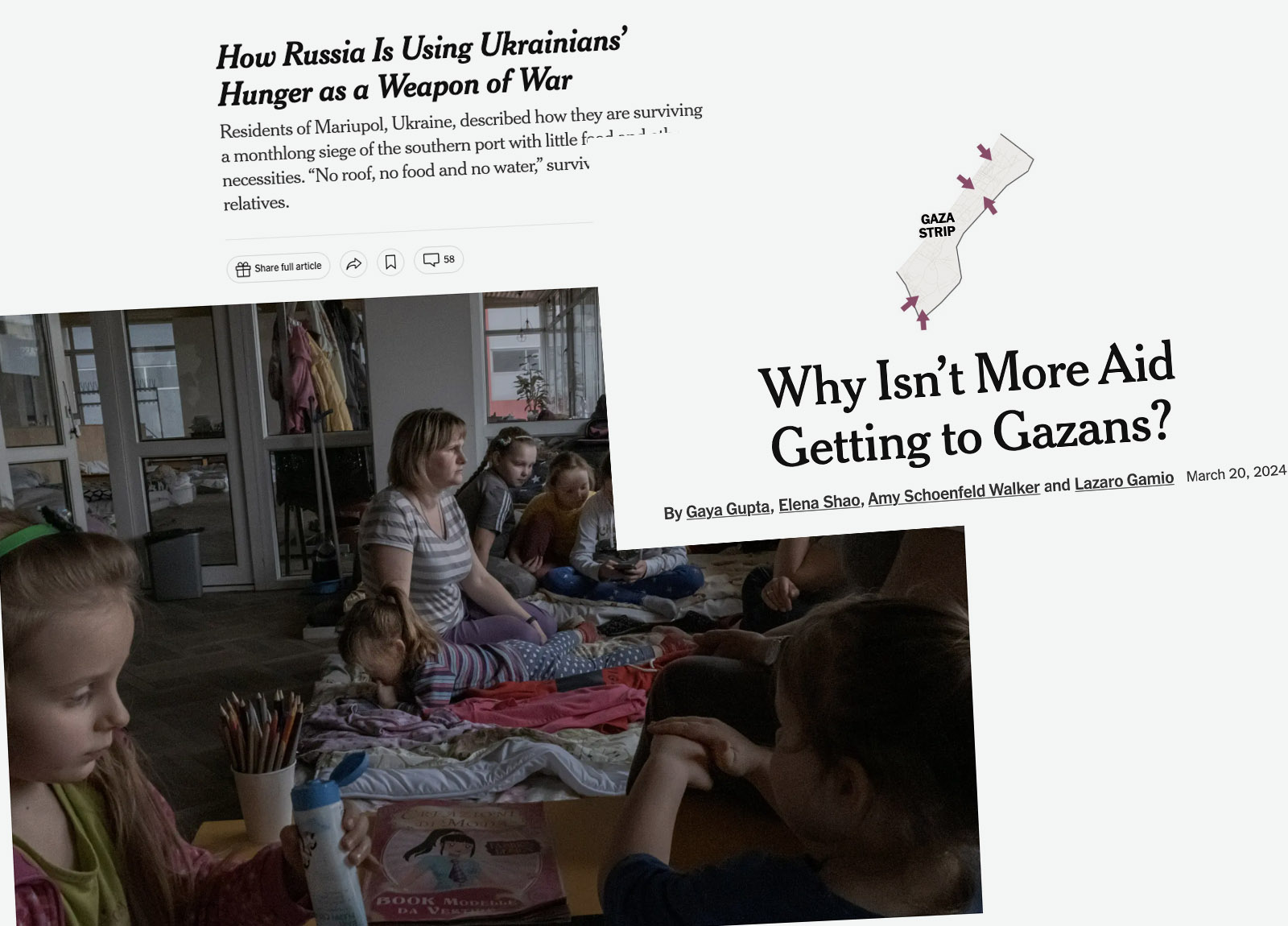
The Times, which for months has deflected blame from Israel for the famine that it has manufactured in Gaza – which numerous Western NGOS and UN officials (sources generally held in high regard by The Times) have declared to be a war crime – were quick to authoritatively blame Russia for “Using Ukrainians’ Hunger as a Weapon of War” during its March 2022 siege of Mariupol.

This front page article on the treatment of Ukrainian prisoners presents a stark contrast to The Times’ reporting on Israel’s torture, rape and murder of Palestinian political prisoners: The Times’ exposé on the Sde Teiman concentration camp buries the worst details at the very end of the article – including prisoners who were sodomized to death by Israeli prison guards – while leading with a headline, sub-head and introduction that don’t mention torture, rape or abuse. The headline’s sober language, “Inside Sde Teiman, the Base Where Israel Detains Gazans,” contrasts with the foregrounding of the worst details when The Times reports on abuses in Russian prisons:
• “Ukrainian Medic’s Months in Russian Cell: Cold, Dirty and Used as a Prop”
• “Accounts of Torture Emerge From Kherson, Ukraine’s ‘City of Fear’”
• “Many Ukrainian Prisoners of War Show Signs of Trauma and Sexual Violence”
• “‘They Expected Me to Die on My Own’: Life as a Ukrainian P.O.W.”
And of course, The Times famously hired a former member of Israeli intelligence with no journalistic experience to manufacture a massive feature story, “Screams Without Words,” which claimed Hamas “weaponized” sexual violence on Oct. 7. Under scrutiny, the testimony and evidence used to prop up this fraudulent story has collapsed.
The Times was similarly sweeping in its denunciation of the Russian military and its deep-seated “military culture of violence.” No parallel reporting exists for the IDF, despite its long and well-documented patterns and culture of dehumanizing Palestinians and committing horrifying war crimes against them with impunity. The closest they come is an article exploring the documentation of war crimes by IDF soldiers themselves, which the paper promptly casts as a deviation from the IDF’s norms and rules.
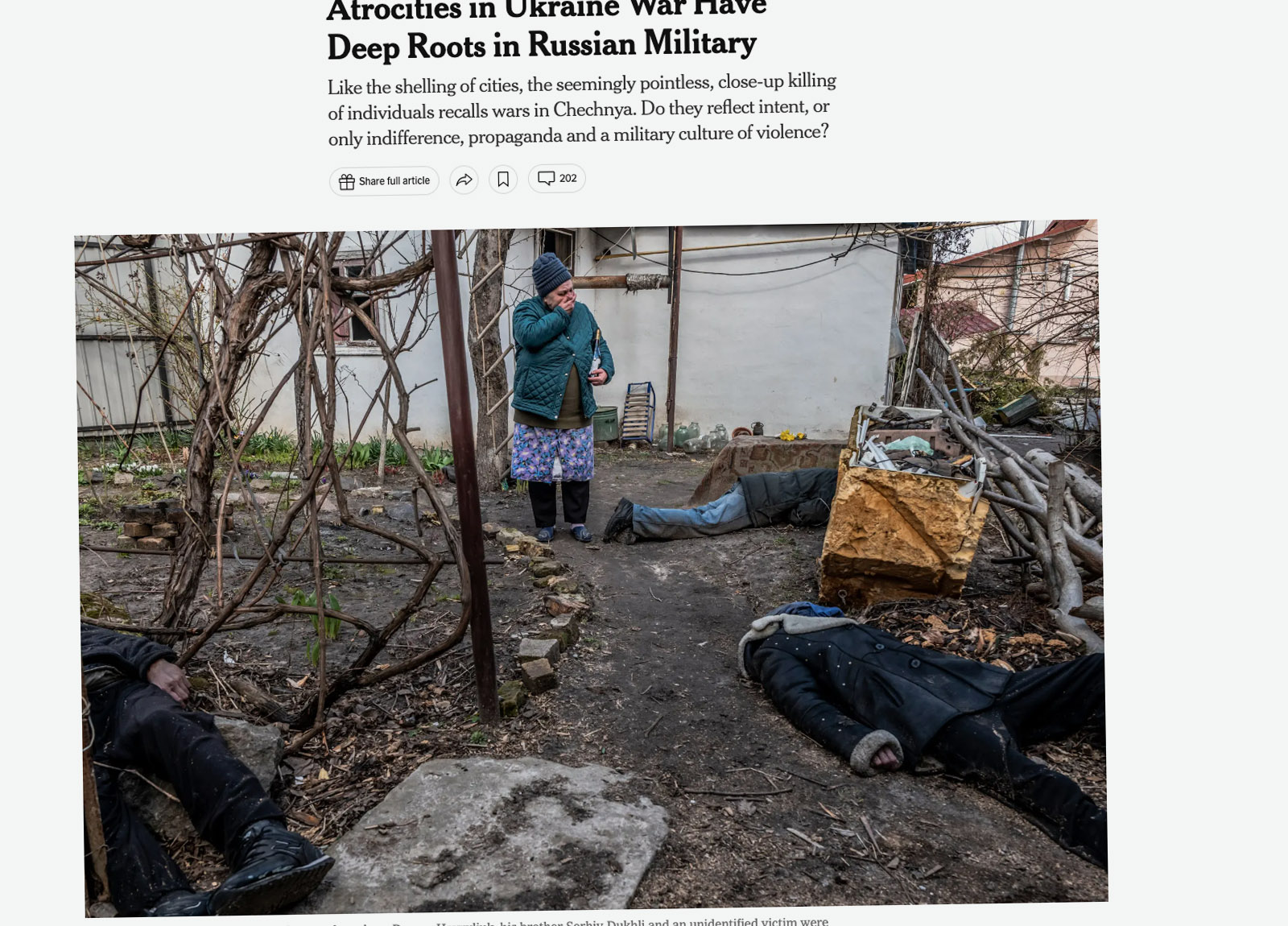
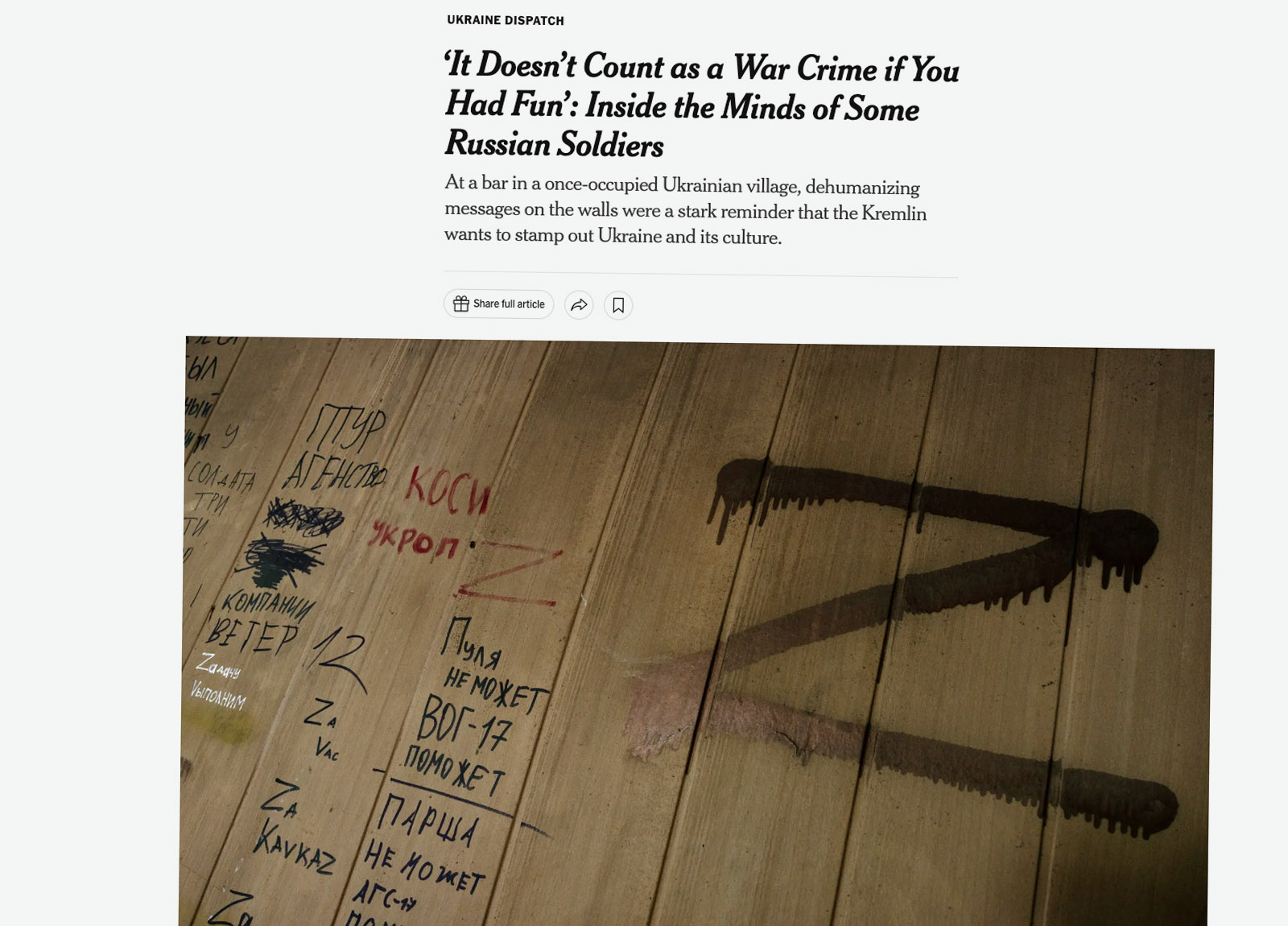
Resistance
The Times unequivocally glorifies, humanizes and legitimizes the Ukrainian army and underground civilian resistance groups. This stands in stark contrast to The Times’ treatment of Hamas and other forms of Palestinian resistance, who are generally cast as terrorists and rarely have their motivations, perspective or strategies explained.
You can find more examples of The Times reporting on Ukrainian resistance to Russian occupation and invasion here.
Perhaps the most damning example is the piece “Behind Enemy Lines, Ukrainians Tell Russians ‘You Are Never Safe’,” which appeared on the front page on Aug. 18 2022. The Times glorifies guerilla warfare, justifies assassinations of collaborators and acts of industrial sabotage, and most remarkably, lauds Ukrainian partisans for “blending into the local population.” In another similarly framed article, “‘This is True Barbarity:’ Life and Death Under Russian Occupation,” the publication describes the resistance tactics of a small Ukrainian town which was occupied by invading Russians early on in the war:
“Early in the occupation, Trostyanets’s police officers took off their uniforms and blended into the populace. Those who were in Ukraine’s Territorial Defense, the equivalent of the National Guard, slipped out to the town’s periphery and worked as partisans – documenting Russian troop movement and reporting it to the Ukrainian military.”
In its retelling of the Ukrainian fight to defend the Azovstal Steelworks in Mariupol (Last Stand at Azovstal: Inside the Siege That Shaped the Ukraine War), The Times does not criticize the Azov Regiment for sheltering with civilians. Rather, they portray it as the logical outcome of an “outgunned” army fighting a defensive war.
“For the next 80 days, Azovstal would be a fulcrum of the war, as Russian brutality collided with Ukrainian resistance. What began as an accident – civilians and soldiers barricaded together inside an industrial complex nearly twice as large as Midtown Manhattan – became a bloody siege as roughly 3,000 Ukrainian fighters kept a vastly larger Russian force bogged down in a quagmire that brought misery and death on both sides.”
We don’t have to use much imagination to picture the “human shields” propaganda that would be deployed if Hamas holed up in an industrial complex with hundreds of Palestinian civilians. In one Morning newsletter, Gaza’s Vital Tunnels,” for instance, Leonhardt writes:
“Hamas has hidden many weapons under hospitals, schools and mosques so that Israel risks killing civilians, and facing an international backlash, when it fights. Hamas fighters also slip above and below ground, blending with civilians.
“These practices mean that Hamas is responsible for many of the civilian deaths, according to international law . . . Deliberately putting military resources near civilians and disguising fighters as civilians are both violations of the laws of war.”
In another piece, The Times cast doubt on an Amnesty International report which accused the Ukrainian military of putting civilians in harm's way by operating in residential areas, schools and hospitals. The article almost exclusively platforms Ukrainians, international observers and legal experts who argue that the Ukrainian military has no choice but to operate out of civilian areas – and that Amnesty’s report is simply feeding into Russian propaganda.
“[The report] was met with widespread and almost universal condemnation in Ukraine, which has been defending itself against a Russian army that has vastly more firepower, which it has used to decimate urban areas and to torture and kill thousands of civilians.”
Hiding amongst civilians is an accusation aimed at Hamas in order to explain away Israeli atrocities. Massacres at hospitals, aid distribution sites, schools, refugee tent cities – all have been justified by the supposed presence of Hamas fighters, which The Times is always quick to remind us is a violation of international law.
But in Ukraine, The Times defends guerilla tactics and favorably frames Ukrainian officials who say that Russia’s invasion “left the country’s military in an increasingly tenuous position: They are putting more civilians in danger with their presence but, especially in bigger towns and cities, have fewer and fewer options when it comes to where they locate their forces.”
The Times’ rare instance of reporting on Hamas’ guerrilla tactics narrates from the U.S.-Israeli perspective and squarely blames Hamas for Israel’s mass murder of civilians.
“They hide under residential neighborhoods, storing their weapons in miles of tunnels and in houses, mosques, sofas – even a child’s bedroom – blurring the boundary between civilians and combatants.”
“Sometimes, they have hid among the few civilians who decided to remain in their neighborhoods despite Israeli orders to evacuate, or accompanied civilians as they returned to areas that the Israelis had captured and then abandoned.”
“Hamas’s decision to keep fighting has proved disastrous for the Palestinians of Gaza . . . Israeli officials say that Hamas’s tactics explain why Israel has been forced to strike so much civilian infrastructure, kill so many Palestinians and detain so many civilians.”
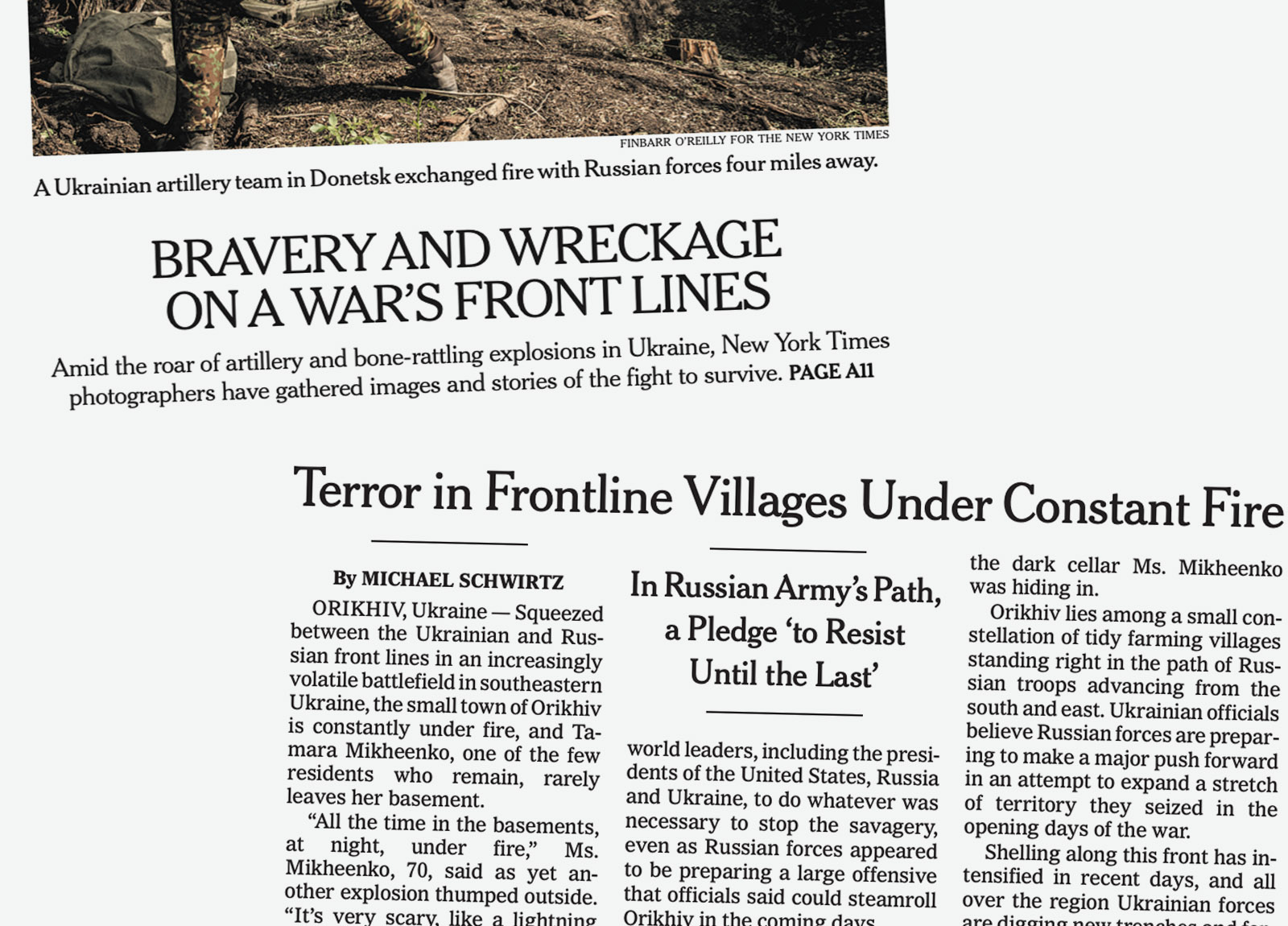
The Times presents Ukrainian civilians and resistance fighters as brave, steadfast warriors: “though vastly outgunned, Ukraine’s army and a growing corps of civilian volunteers are mounting a spirited defense of the capital.” It does not feign a “both-sides” perspective or attempt to undermine resistance: The Ukrainian right to meet invasion and occupation with armed struggle is assumed and validated at every turn.

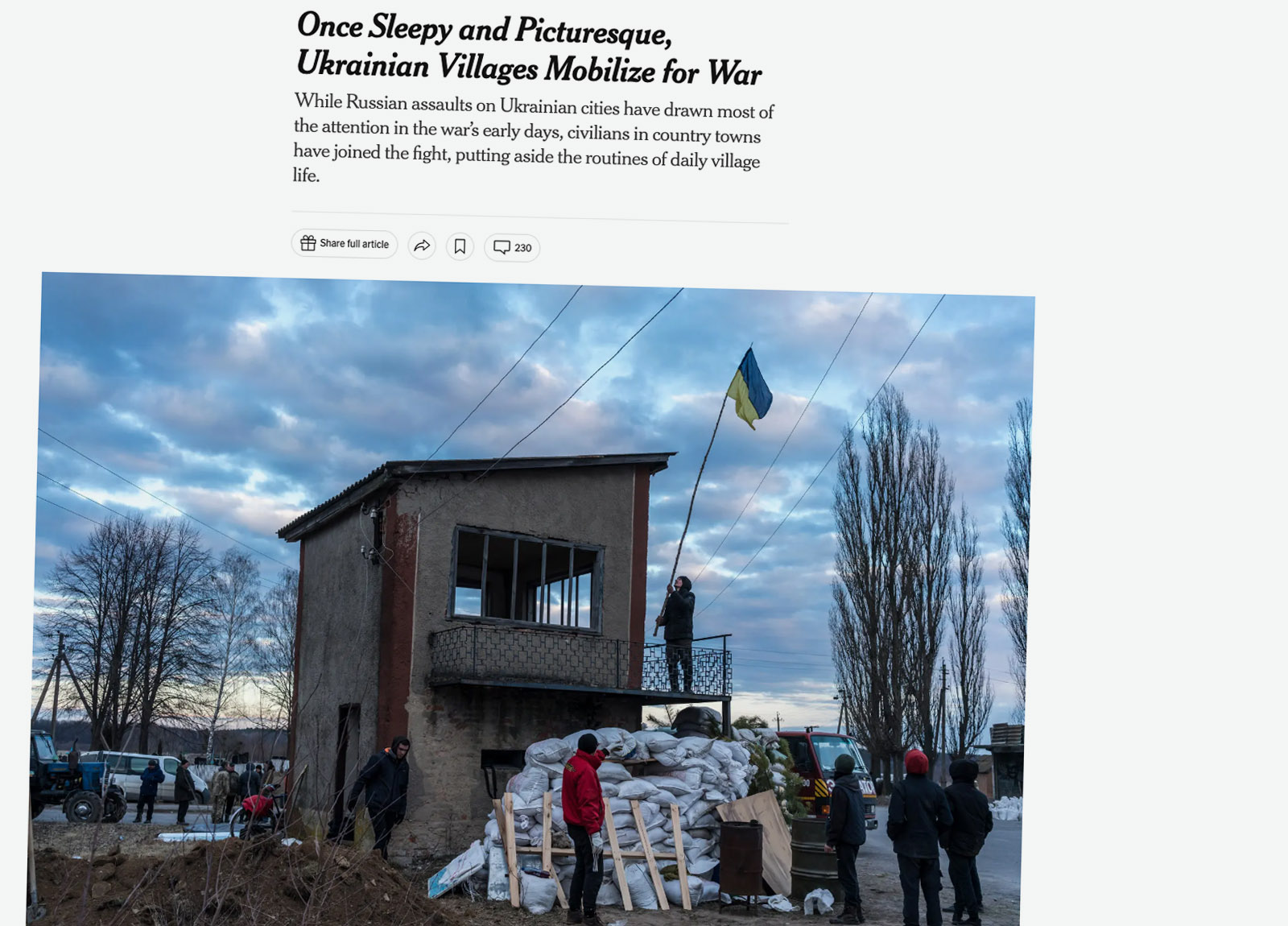
Palestinian civilians who align themselves with Hamas or participate in other resistance activities lose their protected status in the eyes of The Times. One prominent example is its reporting on the Israeli accusation that a handful of United Nations Relief Works Agency (UNRWA) employees were connected to Hamas and the Oct. 7 attacks. The accusation itself was enough for The Times to participate in propagating the Israeli narrative. Within days most international funding was pulled from UNRWA – which employs 14,000 people in Gaza who participate in all aspects of social infrastructure, particularly after Israel imposed a blockade of the Gaza Strip in 2007 – which is the largest provider of aid in Gaza as it suffers through an Israel-engineered famine.
Yet The Times has no trouble glorifying the participation of Ukrainian civilians (trained by the military) in the resistance to Russian occupation. A few examples:
• ‘I’m a Soldier Now.’ Even in Untouched Villages, Ukrainians Prepare to Fight
• ‘Everybody in Our Country Needs to Defend’
• Once Sleepy and Picturesque, Ukrainian Villages Mobilize for War
• Ukrainian Citizens Prepare to Fight Russian Army
You can find more examples of The Times reporting on Ukrainian civilians resisting the Russian invasion here.
The publication uses the Russian occupation to roundly justify the actions of the Ukrainian underground resistance, as seen in the subhead of this June 2022 article: “Guerrilla Attacks Signal Rising Resistance to Russian Occupation.”
“Fueled by brutal Russian repression and worsening humanitarian conditions, Ukrainian partisans appear to be striking deep inside Russian-controlled territory.”
It goes without saying that The Times does not grant this kind of contextual justification to the Palestinian resistance, who are fighting against a six-decade long occupation, an apartheid state and an at least 76-year long campaign of ethnic cleansing backed by the full weight of the most powerful countries and companies in the world.
Ukraine Needs Weapons!
One revealing trend in The Times coverage is their consistent argument-through-reporting that Ukraine needs more funding and more weapons to fight the war. It's so uniform, especially in the early months of the war, that the paper leaves little room for any alternative argument. The political spectrum of responses, as constructed by The Times, is either to support Ukraine and therefore support near-unlimited military aid or to support the Russian invasion.
Often this reporting takes the form of lamenting Ukraine’s lack of modern weaponry (“On Front Lines, Communication Breakdowns Prove Costly for Ukraine”) and the dwindling supplies of available weapons:
• “Shortage of Artillery Ammunition Saps Ukrainian Frontline Morale”
• “Ukraine Worries About Losing Its Biggest Weapon: U.S. Military Aid”
• “With Aid Stalled, Ukraine Scrambles to Make Ends Meet”
• “‘We need more’: U.S.-Sent Missiles Shield Ukraine, but Supply Is Dwindling”
• “Life in a Ukrainian Unit: Diving for Cover, Waiting for Western Weapons”
One example from April of this year, “Ukrainians Wait, Nervously, to See if U.S. Will Provide Critical Aid,” has a sub-head that reads, “From the battlefield to battered cities, soldiers and civilians are counting on Congress to approve $60 billion in military support. Without it, Ukrainian officials say, prospects in the war are grim.”
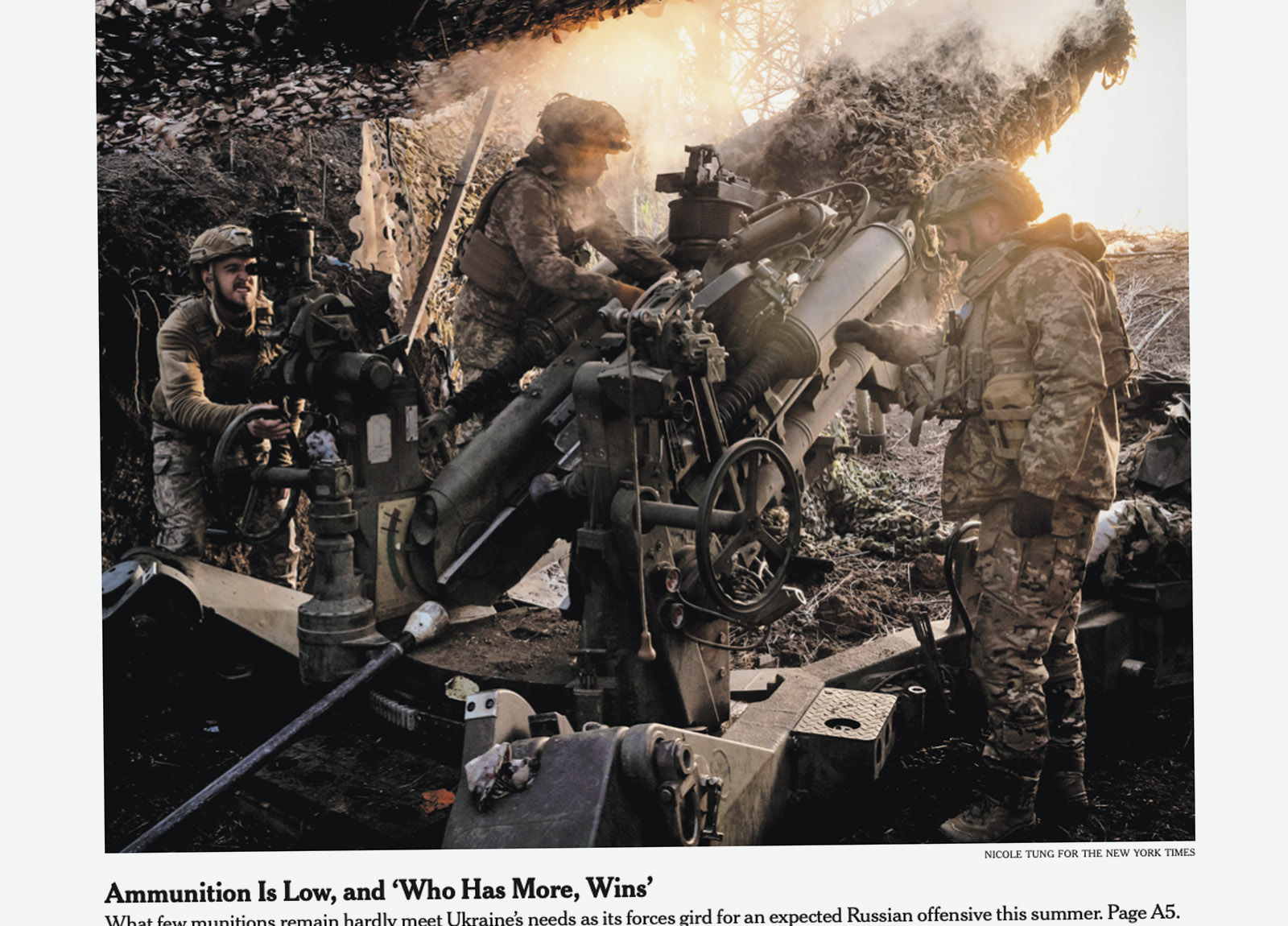
And The Times is quick to highlight when Western-suppplied weapons are making a difference for Ukraine on the battlefield:
• “Armed with new powerful weapons, Ukraine is limiting Russian advances, military analysts say”
• “Advanced U.S. arms make a mark in Ukraine war, officials say”
• “Ukrainian Strikes May Be Slowing Russia’s Advance”
• “The U.S. is sending more rocket launchers that Ukraine says are key to fighting Russia”
• “As Western Arms Pour Into Ukraine, Zelensky Promises Victory”
• “What It Takes to Protect Kyiv From Russian Bombardment”
• “With New Weaponry, Ukraine Is Subtly Shifting Its War Strategy”
The Morning newsletter has helped build this narrative on multiple occasions, writing that “America’s diminished support will likely force Ukraine to cede more land,” and even fear mongering that a lack of American aid would “encourage China to invade Taiwan.”
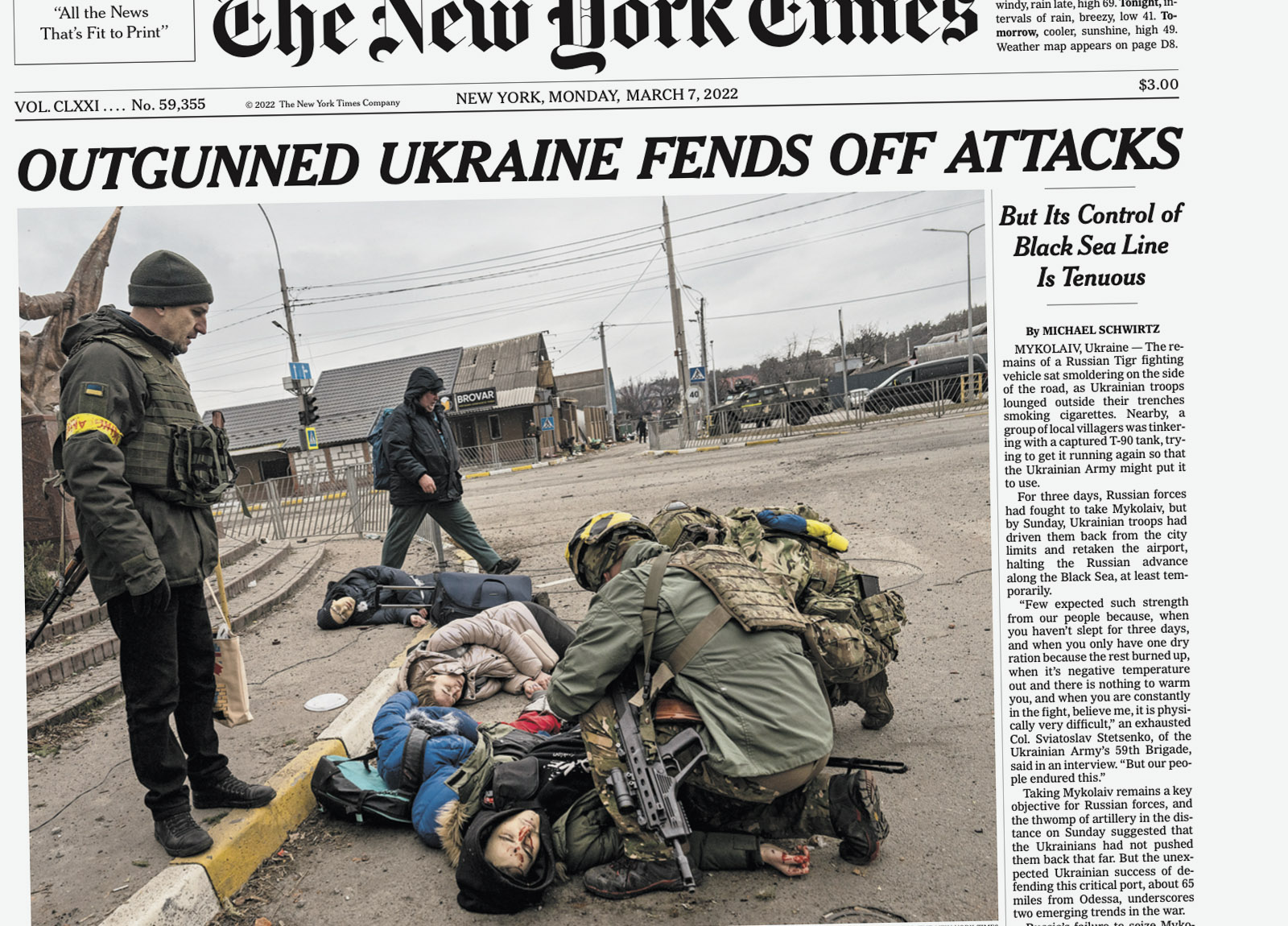
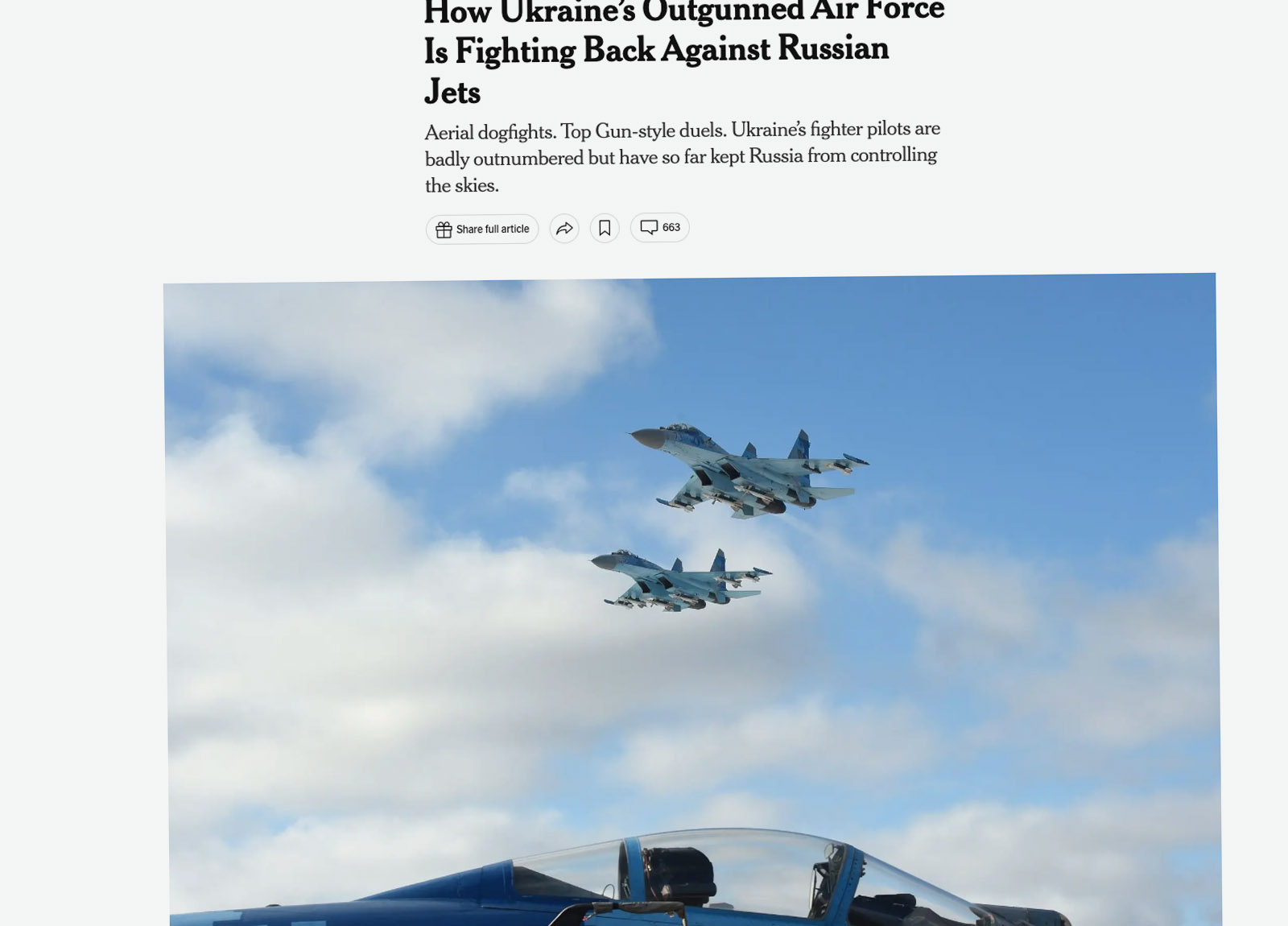
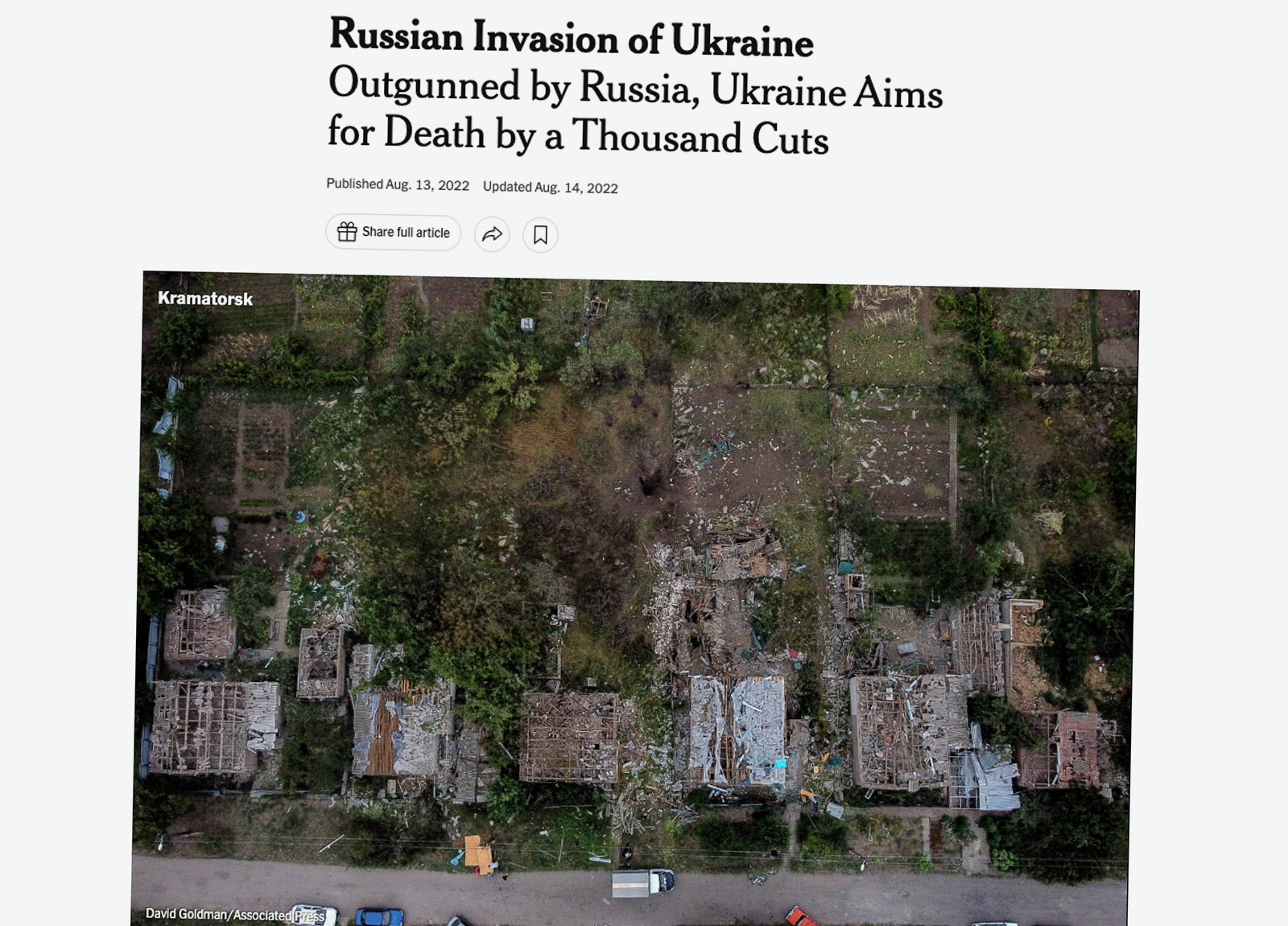
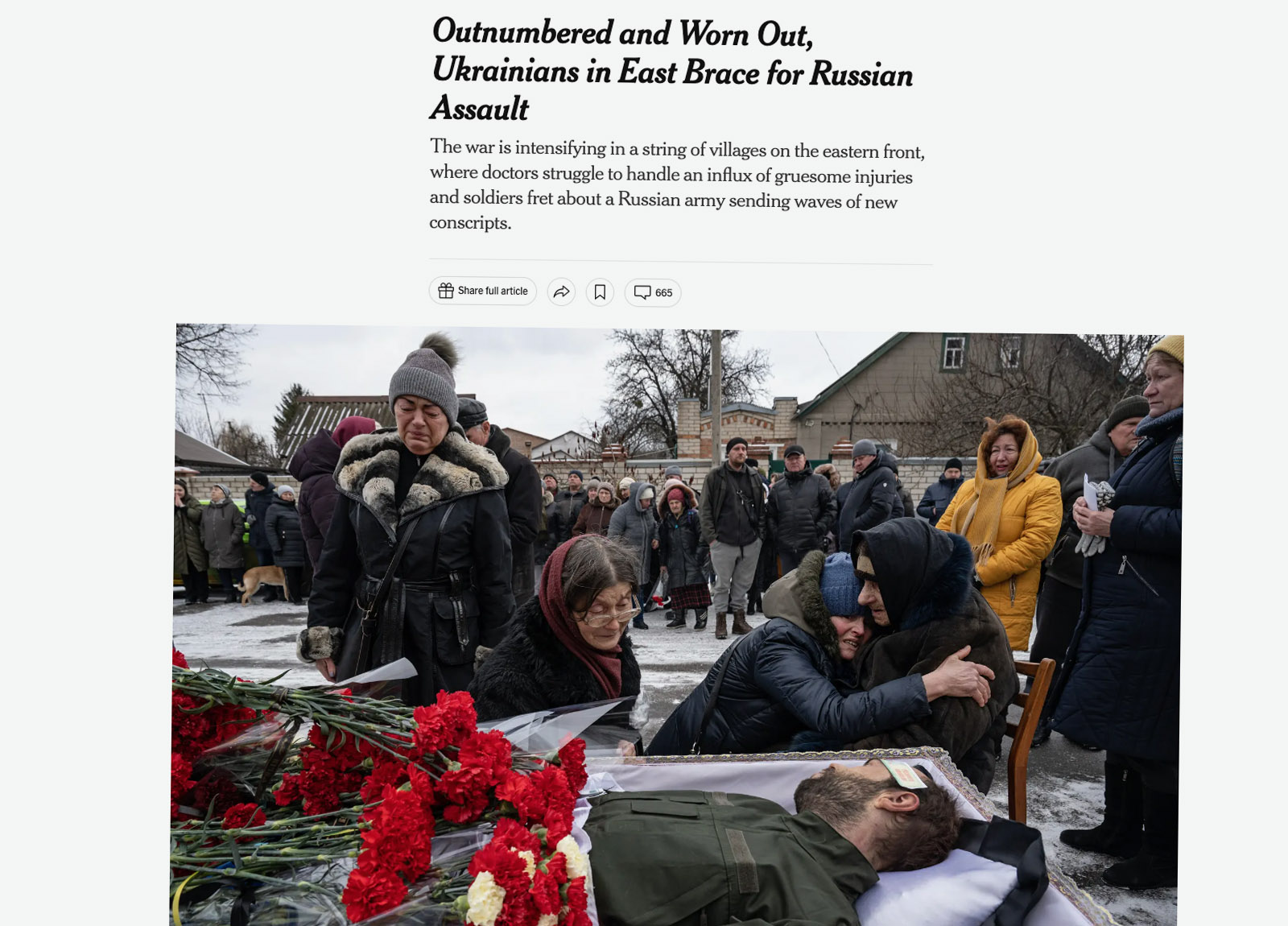
Ukraine is always framed as the David of the story, “outgunned,” “scrappy,” and fighting on despite its disadvantages. We find paragraph constructions like this, from a June 2022 story, “An outgunned Ukraine is adding to the pressure on Europe,” in seemingly straightforward war reporting:
“Ukrainian officials, running out of Soviet-era ammunition in the east and losing more soldiers to Russian shelling, have repeatedly called for more and faster delivery of more modern NATO-country artillery and weapons systems. As Western leaders consider further military aid, the war in the east will largely depend on how fast and in what quantities these heavy weapons arrive, and how quickly Ukrainian soldiers can be taught how best to use them.”
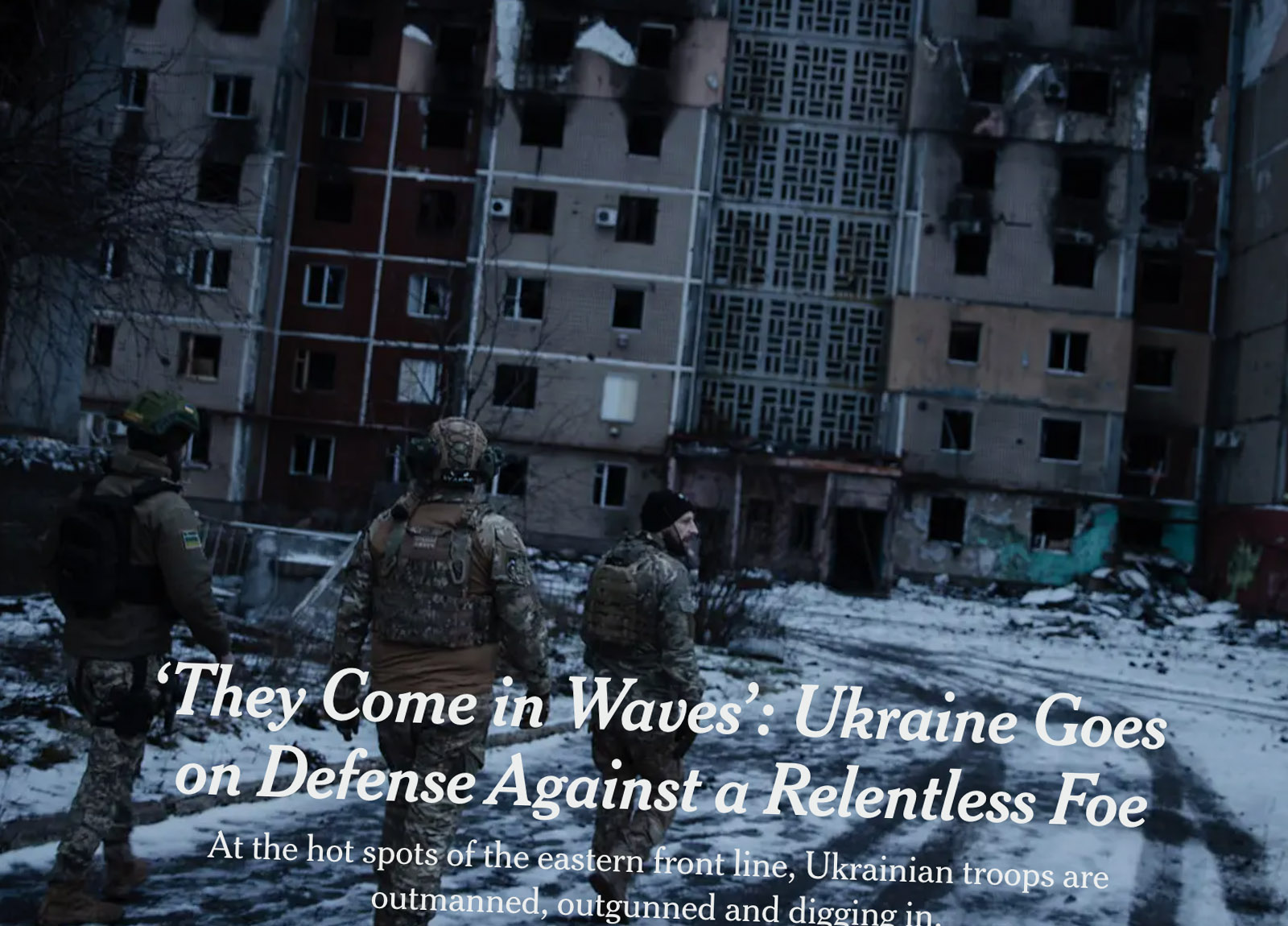
Another long-form report, “‘They Come in Waves’: Ukraine Goes on Defense Against a Relentless Foe” from February of this year, as Western aid threatened to dry up, once again makes an implicit case for military aid, from the sub-head, “Ukrainian troops are outmanned, outgunned and digging in,” to the article itself:
“. . . it is unclear how long Kyiv can sustain its defense if its Western allies do not continue to provide robust military support . . .”
“As supplies and ammunition dwindle, Ukrainians said they would have to pay a higher price in blood to simply hold their lines.”
Hamas and the broader Palestinian resistance are never depicted as plucky underdogs – despite the fact that they are fighting siege, invasion, occupation and apartheid perpetrated by one of the world’s most well-equipped and funded armies.
Arts and Culture
One striking aspect of The Times’ coverage of the war in Ukraine is its commitment to reporting on the cultural front. The paper’s arts sections are inundated with odes to a culture under threat that tethers Ukrainians to the national identity they are fighting to protect. Some border on the absurd, like the infamous profile of Zelensky’s green t-shirt, “The Man in the Olive Green Tee.” Here’s one excerpt from the near-pornographic profile:

“Along with the photos of bodies lying lifeless on the streets, and bombed out theaters and apartment buildings, [the shirt] will be one of the defining images of the conflict. It is a metaphor in cloth for the growing narrative of a Russian Goliath and Ukrainian David, of hubris and heroism, that is being played out in blood and arms.”
The Times wrote features on Ukrainian techno collectives, resistance to Russification, the “decolonization” of Ukrainian art, resilient theater groups and the preservation of art in wartime. Meanwhile, its culture critics assessed “The Role of Art in a Time of War,” writing authoratatively in the lede: “You do not have to go far outside of Kyiv to see how the massacre of civilians and the trampling of culture still come one after the other.” Another headline declared “The War in Ukraine Is the True Culture War,” as the author definitively describes the Russian assault on Ukrainian culture:
“With Russia actively trying to erase Ukraine’s national identity, this country’s music, literature, movies and monuments are not recreations. They are battlefields. The true culture war of our age is the war for democracy, and Ukrainian culture, past and present, has become a vital line of defense for the whole liberal order.”

In Gaza, most cultural institutions have been reduced to rubble: Israel has deliberately destroyed every university in Gaza; it has targeted primary schools, mosques, libraries and archives; and its soldiers often gloat about their war crimes on social media. The sickening photo of an IDF soldier sitting gleefully in a Gaza library as it burns behind him is emblematic of Israel’s campaign to exterminate Palestinian culture. Yet The Times has not treated this as a crisis. Most of its arts reporting has focused on the so-called “free speech” battles in the Western world. The arts sections have covered disputes in the Western literary world yet have thus far refused to analyze or, frankly, acknowledge that the basis for Palestinian cultural production is being razed.
Conclusion
What do we gain from this? A measure of the sheer anti-Palestinian racism and Zionist apologism which courses through the veins of The New York Times, for one. This study should also demonstrate that The Times, despite its claims of objectivity and pursuit of the truth, picks sides – especially in conflicts with serious geopolitical consequences for U.S. empire. The paper has firmly taken the side of U.S. hegemony (and has a long leash for Zionism, like many American politicians). This shapes The Times’ language, its topic choice, and its manner of framing events – in order to support U.S. foreign policy goals.
The United States has a clear interest in painting Russia – one of its main geopolitical rivals – as the thuggish aggressor in Ukraine that commits war crimes for sport and presents an existential challenge to Western civilization. And it legitimizes its military aid and diplomatic support by portraying Ukrainians as the scrappy underdogs that resist in whatever way necessary (with Western weapons) to protect their homeland.
In Gaza, the United States has an interest in presenting Israel, its bedrock ally in the Middle East, as a nation defending itself from existential threats that is forced to make hard choices between destroying bloodthirsty terrorists and killing civilians en masse. Palestinian resistance has to be completely decontextualized, its motivations and history erased. It is necessarily presented as a cruel, ISIS-like beast which is driven by a single-minded desire to slaughter Jewish people.
In both cases, like the imperial stenographers that they are, The New York Times editors dutifully launder the empire’s preferred narrative.


